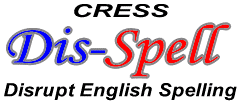CRESS has been very carefully designed to be as close to standard spelling as possible. This means you can read it without knowing it at all.
Here’s a sentence in CRESS, and we bet you can read it easily:
- Nau iz da taim for al gud men and wiman tu kam tu da ed av der kantri
Here’s a sentence you haven’t seen before. Can you read it?:
- Ai laik vedztabal sup wis litl animalz in it.
You can easily see the sentence: “I like vegetable soup with little animals in it.” The lesson here is not to be afraid of something new with great benefit, especially if it isn’t that new.
It is extremely important that with the slightest bit of attention anyone can read CRESS English even if they don’t know it. Some people joke that it’s just like a French accent that we can can all understand. The French sometimes say wis for with, and we can understand.
But yes, you would be well to ask how in the world that system would be learned.
The answer is easy peasy, because that was BARE CRESS with the arrow symbols removed. When you learn CRESS you add three simple arrows to indicate the tongue positions you already know if you speak English.
When you put those arrow symbols in CRESS is simply writing the sounds you say, in a perfectly regular and consistent manner.
Here’s the same sentence in CRESS with arrows for learners. If you can say a word you can spell it: sounding it out is now easy and reliable… the whole story.
- Ai laik vedz>ta^b^al su^p wis< lit^l a<nima^lz in it.
Because it uses what you already know CRESS is easy to learn. The place to help you begin is the Tutorial page, but we give the basic hints below to convey the basic concept.
Look at the right arrow after the first d. Why is it there? Well because if you consciously pull the tonge tip back saying a long buzzing z sound, you will get a different sound, the one in the middle of the word ‘measure’.
Now look at the two cases of a^ with up arrow in ‘vegetable’. What’s that about? Well make a long a sound as in ‘father’. Now as you stretch out that a for a second or two force your jaw and tongue up a little bit. You will get the first sound in the word ‘about’, and that is the sound you have twice in ‘vegetable’.
